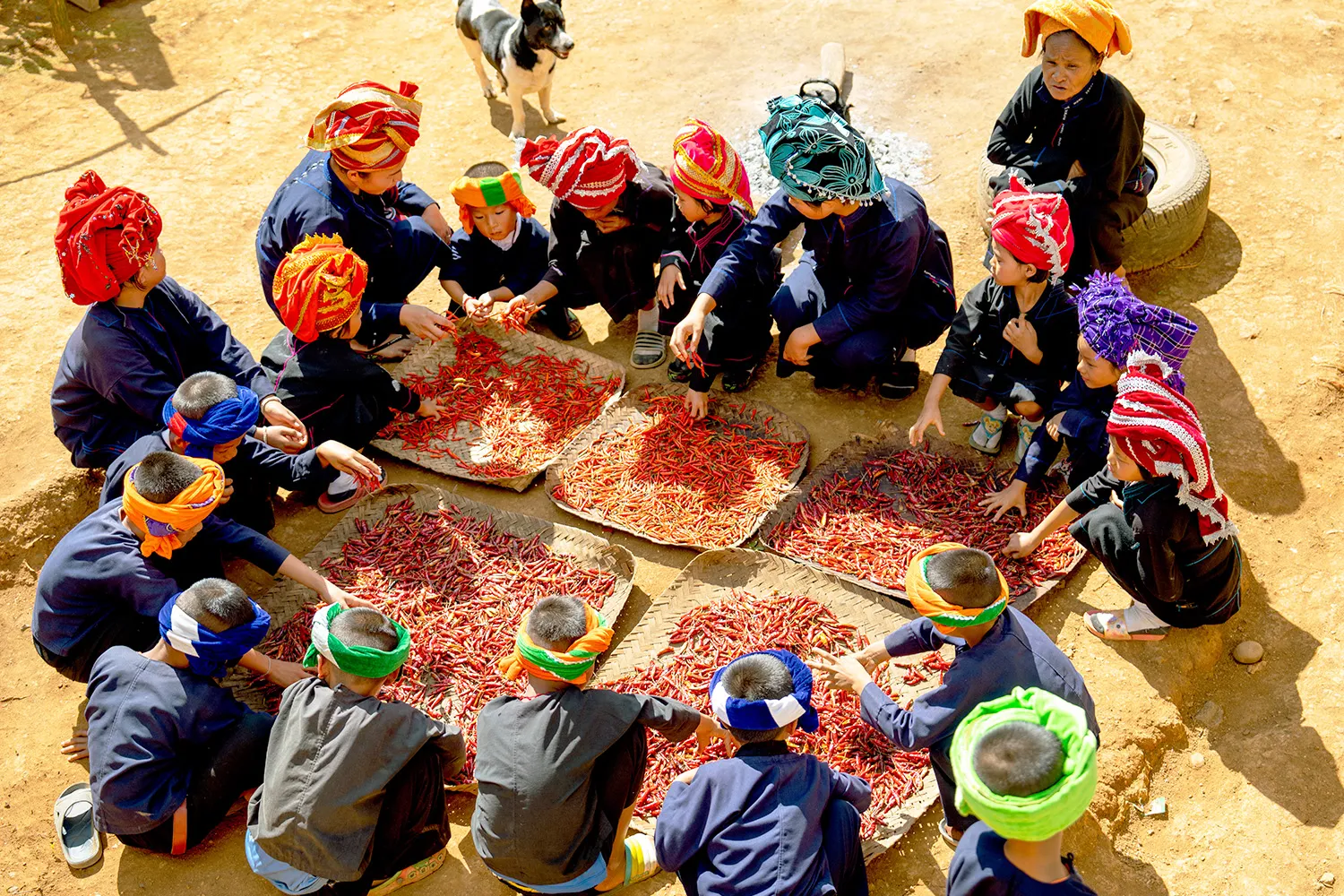Origins and Migration:
The Pa-O people, often referred to as the Taungthu (meaning ‘hill farmers’), are a distinct ethnic group primarily originating from the Shan State in Myanmar, and they constitute a notable, though smaller, hill tribe population in Thailand. Historically, the Pa-O trace their ancestry to the ancient Thaton kingdom, suggesting a profound history in the region that links them to the Mon people. Legend holds that they once wore brightly colored clothing until they were defeated and forced to wear indigo-dyed black garments to signify their subdued status, a tradition they maintain to this day as a marker of their identity. Their migration into Thailand began centuries ago but increased significantly in the late 19th and 20th centuries, often alongside the Shan people, driven by trade opportunities and, more recently, by political instability and military conflicts in Myanmar. In Thailand, Pa-O communities are found predominantly in the remote forested mountains of Mae Hong Son and pockets of Chiang Mai, where they have preserved their unique Pa-O language, which belongs to the Tibeto-Burman family, and maintained a strong cultural distinction from other ethnic groups, including the various sub-groups of the Karen.
Traditional Livelihoods:
The traditional lifestyle and livelihoods of the Pa-O are deeply agricultural, reflecting their name as ‘hill farmers.’ Their primary occupation is subsistence farming in the uplands, utilizing mountainous terrain to cultivate a variety of crops. Key staples include rice, corn, beans, and sesame, grown using traditional methods of rotational cultivation that rely on the rainy season. Unlike some neighboring groups, the Pa-O were traditionally less involved in the opium trade and have successfully focused on diverse, sustainable crop production and animal husbandry, raising livestock such as pigs and chickens. Their strong ties to the Shan people have also led to some Pa-O historically engaging in trade and commerce, with some groups establishing businesses and market stalls in lowland towns like Chiang Mai. Today, Pa-O villages remain relatively remote, and while the younger generations increasingly seek opportunities in the Thai economy, the village economy continues to be anchored in agriculture and the production of textiles and bamboo handicrafts.
Culture, Religion, and Spirituality:
Pa-O culture and religion are marked by a deep synthesis of Theravada Buddhism and traditional animism (spirit worship). Buddhism is central to the Pa-O identity, a cultural trait they share with the Shan and Mon peoples, with virtually every village featuring a temple or shrine. They uphold Buddhist principles and actively participate in religious practices, making them one of the most devoutly Buddhist of the recognized hill tribes. However, their reverence for Buddhism coexists with a strong belief in the spiritual world, including the worship of ancestor spirits and various nature spirits (nat in Burmese tradition) that are thought to reside in the forests, streams, and specific landmarks. Religious and spiritual life is traditionally managed by monks and respected village elders, who also uphold a strict, honor-based social structure centered on the extended family. Pa-O culture emphasizes hard work, honesty, and community harmony, values that are reinforced through their shared religious practices and festivals.
Distinctive Traditional Attire:
The traditional clothing of the Pa-O is their most immediately identifiable cultural feature, distinguishing them sharply from the more colorful hill tribes. Both men and women wear clothing primarily made from hand-woven cotton fabric dyed a deep indigo or black. This dark color symbolizes their traditional history of subjugation, a legend they have transformed into a powerful cultural statement. Pa-O women are particularly distinct: they wear a black long sarong or tubular skirt, a black V-neck or short-sleeved T-shirt, and a long-sleeved cropped jacket with an open chest and a mandarin collar, often trimmed with red stripes. Most notably, they wear a unique, brightly colored turban (often orange, yellow, or red) that is wrapped high and tight around the head, resembling a large, stacked coil. Pa-O men wear black or dark blue jogger-style pants (Shan baun-bi) and jackets, often with a matching dark shoulder bag (yahm). This uniform dark attire, broken only by the women’s vibrant turban, is strictly adhered to during all religious and festive occasions, cementing their unity and cultural pride.
Village Architecture and Social Structure:
Pa-O village structure and house construction are typically utilitarian and adapted for the mountainous environment, reflecting a pragmatic and community-focused lifestyle. Pa-O villages are traditionally situated amidst remote forested mountains. Their houses are generally built on stilts, utilizing local materials like bamboo and wooden boards to create a sturdy, elevated dwelling. Building on stilts is a practical measure, preventing dampness and protecting the living area from potential pests and animals. The typical home is a large single-room structure designed to accommodate an extended family, with a central cooking area. Given their deep commitment to Buddhism, many Pa-O villages have a prominent Buddhist temple or a central structure for communal and religious activities, which often serves as the cultural focal point. While new construction increasingly incorporates modern materials, the traditional raised-platform design and community-centric layout remain the preferred architectural style, maintaining the village’s traditional aesthetic.
Festivals and Ceremonies:
The Pa-O have a vibrant calendar of festivals and religious ceremonies that are central to their community life and are largely intertwined with the Buddhist calendar. The most significant annual event is the Pa-O New Year Celebration, which typically coincides with the full moon day of Tabaung (around March), commemorating the legendary birth of their ancient king, Suriya Chanda. This festival is a major time of pilgrimage, feasting, and community gathering, where the Pa-O dress in their complete traditional attire to participate in parades and religious rites. Another distinctive ceremony is the Fire Rocket Festival (or Phra-Che-Ka) in the hot season, celebrated to bring on the rains for the upcoming rice planting season and to pay homage to the Naga (serpent dragon) from their origin myth. Life-cycle events, such as marriages and funerals, are also highly formalized ceremonies that incorporate a blend of Buddhist rites and traditional spirit-appeasing rituals, reinforcing both their spiritual beliefs and the communal bonds.

